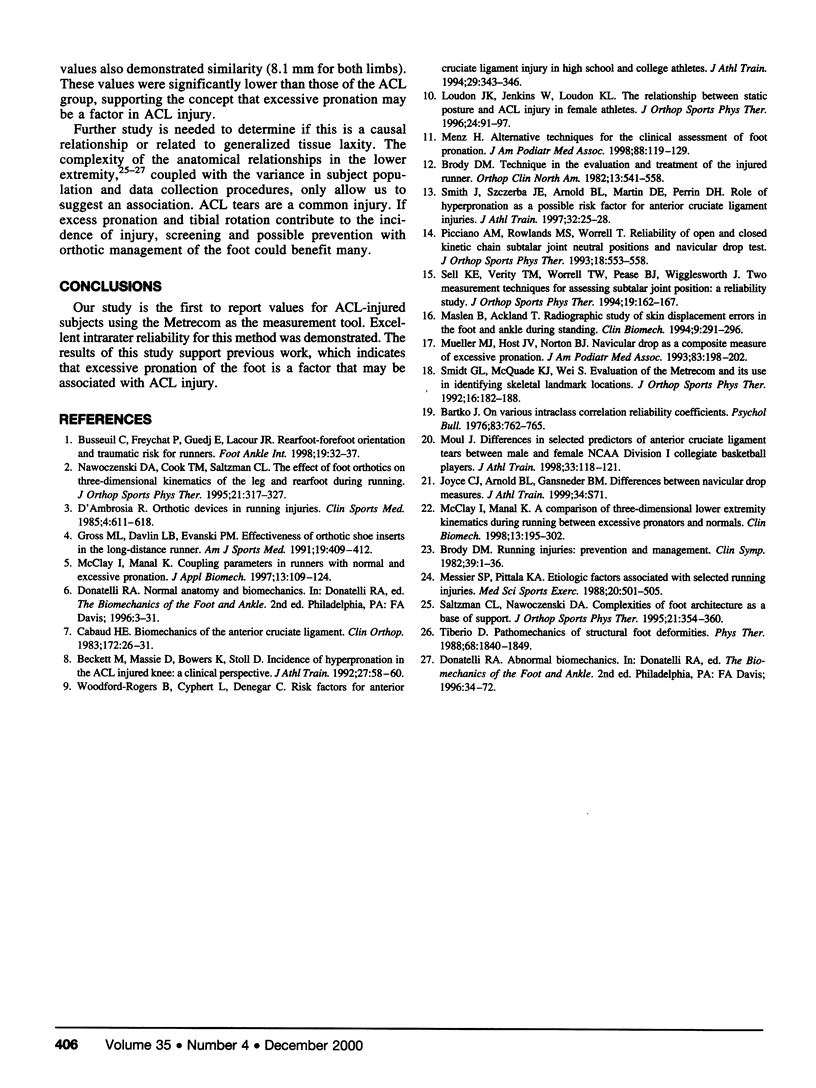Abstract
Objective:
Research suggests that excessive pronation of the foot contributes to the incidence of anterior cruciate ligament (ACL) tears by increasing internal tibial rotation. Studies have documented greater navicular drop values in individuals with a history of an ACL tear using methods that may not accurately follow the motion of underlying bone. The purpose of our investigation was to compare the navicular drop of subjects with a history of ACL tears with healthy controls when measured by a Metrecom.
Subjects:
Eighteen subjects previously diagnosed with a torn ACL were matched by age, sex, and limb to noninjured control subjects.
Design and Setting:
Static group comparisons of navicular drop in subjects with an injured ACL and subjects having no history of ACL injury.
Measurements:
A single investigator performed the measure of navicular drop. The position of the navicular tuberosity was digitized while the subject stood barefoot on a flat surface in subtalar joint neutral and in relaxed stance. Intrarater reliability was assessed using intraclass correlation coefficient and standard error of the measurement. An independent t test assessed the difference between the amount of navicular drop in the ACL group and the controls.
Results:
Analysis of repeated measures, intraclass correlation coefficient (2,1), demonstrated intrarater reliability for the measure of navicular drop to be 0.90; the standard error of measurement was 1.19 mm. The independent t test showed a statistically greater amount of navicular drop in the ACL group.
Conclusions:
Excellent intrarater reliability was demonstrated when using the Metrecom to measure navicular drop. Excessive subtalar joint pronation, measured as navicular drop, was identified as 1 factor that may contribute to ACL injury.
Keywords: pronation, internal tibial rotation, navicular bone
Full text
PDF



Images in this article
Selected References
These references are in PubMed. This may not be the complete list of references from this article.
- Beckett M. E., Massie D. L., Bowers K. D., Stoll D. A. Incidence of Hyperpronation in the ACL Injured Knee: A Clinical Perspective. J Athl Train. 1992;27(1):58–62. [PMC free article] [PubMed] [Google Scholar]
- Brody D. M. Running injuries. Prevention and management. Clin Symp. 1987;39(3):1–36. [PubMed] [Google Scholar]
- Brody D. M. Techniques in the evaluation and treatment of the injured runner. Orthop Clin North Am. 1982 Jul;13(3):541–558. [PubMed] [Google Scholar]
- Busseuil C., Freychat P., Guedj E. B., Lacour J. R. Rearfoot-forefoot orientation and traumatic risk for runners. Foot Ankle Int. 1998 Jan;19(1):32–37. doi: 10.1177/107110079801900106. [DOI] [PubMed] [Google Scholar]
- Cabaud H. E. Biomechanics of the anterior cruciate ligament. Clin Orthop Relat Res. 1983 Jan-Feb;(172):26–31. [PubMed] [Google Scholar]
- D'Ambrosia R. D. Orthotic devices in running injuries. Clin Sports Med. 1985 Oct;4(4):611–618. [PubMed] [Google Scholar]
- Gross M. L., Davlin L. B., Evanski P. M. Effectiveness of orthotic shoe inserts in the long-distance runner. Am J Sports Med. 1991 Jul-Aug;19(4):409–412. doi: 10.1177/036354659101900416. [DOI] [PubMed] [Google Scholar]
- Loudon J. K., Jenkins W., Loudon K. L. The relationship between static posture and ACL injury in female athletes. J Orthop Sports Phys Ther. 1996 Aug;24(2):91–97. doi: 10.2519/jospt.1996.24.2.91. [DOI] [PubMed] [Google Scholar]
- McClay Irene, Manal Kurt. A comparison of three-dimensional lower extremity kinematics during running between excessive pronators and normals. Clin Biomech (Bristol, Avon) 1998 Apr;13(3):195–203. doi: 10.1016/s0268-0033(97)00029-6. [DOI] [PubMed] [Google Scholar]
- Menz H. B. Alternative techniques for the clinical assessment of foot pronation. J Am Podiatr Med Assoc. 1998 Mar;88(3):119–129. doi: 10.7547/87507315-88-3-119. [DOI] [PubMed] [Google Scholar]
- Messier S. P., Pittala K. A. Etiologic factors associated with selected running injuries. Med Sci Sports Exerc. 1988 Oct;20(5):501–505. [PubMed] [Google Scholar]
- Moul J. L. Differences in Selected Predictors of Anterior Cruciate Ligament Tears Between Male and Female NCAA Division I Collegiate Basketball Players. J Athl Train. 1998 Apr;33(2):118–121. [PMC free article] [PubMed] [Google Scholar]
- Mueller M. J., Host J. V., Norton B. J. Navicular drop as a composite measure of excessive pronation. J Am Podiatr Med Assoc. 1993 Apr;83(4):198–202. doi: 10.7547/87507315-83-4-198. [DOI] [PubMed] [Google Scholar]
- Nawoczenski D. A., Cook T. M., Saltzman C. L. The effect of foot orthotics on three-dimensional kinematics of the leg and rearfoot during running. J Orthop Sports Phys Ther. 1995 Jun;21(6):317–327. doi: 10.2519/jospt.1995.21.6.317. [DOI] [PubMed] [Google Scholar]
- Picciano A. M., Rowlands M. S., Worrell T. Reliability of open and closed kinetic chain subtalar joint neutral positions and navicular drop test. J Orthop Sports Phys Ther. 1993 Oct;18(4):553–558. doi: 10.2519/jospt.1993.18.4.553. [DOI] [PubMed] [Google Scholar]
- Saltzman C. L., Nawoczenski D. A. Complexities of foot architecture as a base of support. J Orthop Sports Phys Ther. 1995 Jun;21(6):354–360. doi: 10.2519/jospt.1995.21.6.354. [DOI] [PubMed] [Google Scholar]
- Sell K. E., Verity T. M., Worrell T. W., Pease B. J., Wigglesworth J. Two measurement techniques for assessing subtalar joint position: a reliability study. J Orthop Sports Phys Ther. 1994 Mar;19(3):162–167. doi: 10.2519/jospt.1994.19.3.162. [DOI] [PubMed] [Google Scholar]
- Smith J., Szczerba J. E., Arnold B. L., Perrin D. H., Martin D. E. Role of hyperpronation as a possible risk factor for anterior cruciate ligament injuries. J Athl Train. 1997 Jan;32(1):25–28. [PMC free article] [PubMed] [Google Scholar]
- Tiberio D. Pathomechanics of structural foot deformities. Phys Ther. 1988 Dec;68(12):1840–1849. doi: 10.1093/ptj/68.12.1840. [DOI] [PubMed] [Google Scholar]
- Woodford-Rogers B., Cyphert L., Denegar C. R. Risk factors for anterior cruciate ligament injury in high school and college athletes. J Athl Train. 1994 Dec;29(4):343–346. [PMC free article] [PubMed] [Google Scholar]




